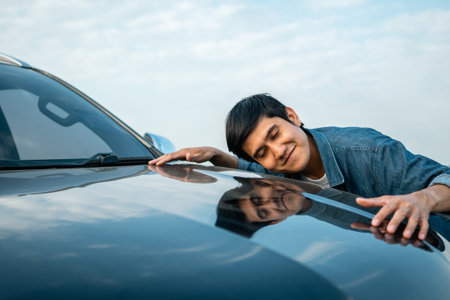1. The Thrill of Speed and Adrenaline
For many street racers, the rush of adrenaline is one of the main attractions of illegal racing. The feeling of pressing the gas pedal, hearing the engine roar, and watching the scenery blur as they push their cars to the limit gives them an intense thrill. It’s a sensation that is hard to replicate in daily life, making it highly addictive for those who crave excitement and high-speed competition.
Why Speed Feels So Addictive
Speed triggers a natural response in the human body. When racing, the body releases adrenaline, which increases heart rate, sharpens focus, and enhances reaction times. These physiological changes create a sense of exhilaration and an almost euphoric state. Over time, street racers may start seeking this rush more often, pushing their limits further each time they hit the streets.
The Science Behind the Adrenaline Rush
| Factor | How It Affects Street Racers |
|---|---|
| Adrenaline Surge | Boosts energy, sharpens reflexes, and enhances focus |
| Increased Dopamine | Creates feelings of pleasure and reward, reinforcing the habit |
| Heightened Awareness | Improves perception of surroundings and response speed |
The Psychological Escape
Aside from the physiological effects, speed provides a mental escape for many street racers. The moment they start racing, all their worries fade, and they enter a state of intense concentration known as “the zone.” This ability to disconnect from everyday stress makes racing even more appealing, turning it into both a thrill and an escape from reality.
What Keeps Racers Coming Back?
- The sense of power and control over their vehicle
- The competitive nature of racing against other skilled drivers
- The admiration and recognition from peers within the racing community
- The ever-present challenge of pushing their car and themselves to new limits
Final Thoughts on the Adrenaline Factor
Understanding the appeal of speed and adrenaline helps us see why street racing is so addictive. It’s not just about winning – its about the feeling of excitement, the challenge, and the escape from reality that keeps racers coming back for more.
2. The Need for Competition and Dominance
Street racing isn’t just about speed—it’s about proving who’s the best. Many street racers thrive on the competition, constantly looking for ways to outperform others. There’s an undeniable thrill in lining up against another car, the engines roaring, and the anticipation of victory driving them forward.
Why Racers Feel the Need to Compete
At its core, street racing embodies a deep psychological drive for dominance. Many racers see their cars as extensions of themselves. Winning a race isnt just about being the fastest; its about cementing their reputation, gaining respect, and proving their skills.
Key Motivations Behind Competitive Street Racing
| Motivation | Description |
|---|---|
| Reputation | Winning races helps racers earn status and recognition in their communities. |
| Adrenaline Rush | The thrill of high-speed competition provides a rush that few other activities can match. |
| Dominance | Outperforming others on the road allows racers to assert their skills and superiority. |
| Pride in Vehicle | Racers take pride in their customized cars and want to prove their modifications are the best. |
How Street Racers Establish Superiority
For many racers, it’s not enough to just win—they want to consistently dominate the scene. This is why they invest heavily in vehicle modifications, fine-tune their driving skills, and carefully choose opponents they want to challenge. Online forums, social media, and local meetups help spread their reputation, making their victories known to a wider audience.
The Role of Social Recognition
Respect from peers plays a huge role in the competitive nature of street racing. Being the fastest racer on the block guarantees more challengers and even more admiration. The racing culture thrives on this recognition, fueling an endless cycle of competition and one-upmanship.
![]()
3. Social Influence and Peer Pressure
Street racing is not just about speed or skill; it is also deeply influenced by social dynamics. Many racers are drawn into this underground world due to the environment they are surrounded by. Friends, rivals, and social circles can all play a role in pushing someone toward illegal racing.
The Power of Social Circles
For many street racers, their involvement starts with a group of friends who share the same passion for cars and speed. Being part of a close-knit community that encourages risk-taking can make it difficult to resist the pull of illegal racing. The conversations, the excitement, and the shared experiences create a bond where racing feels like a natural step.
Reputation and Status
In the street racing scene, reputation is everything. A driver’s skills, victories, and even the car they drive determine their status within the community. Many racers compete not just to test their own abilities but to earn respect from their peers. A good reputation can lead to more race opportunities, stronger social connections, and in some cases, even sponsorships from local auto shops.
Factors That Influence Street Racers
| Factor | Impact on Racers |
|---|---|
| Social Circles | Encourages participation and offers support |
| Reputation | Increases motivation to race and improve skills |
| Peer Validation | Creates pressure to take risks for approval |
Peer Validation and Risk-Taking
Another driving force behind illegal racing is peer validation. Many racers feel the need to prove themselves to gain approval from their friends and fellow competitors. This pressure can lead them to take greater risks, such as racing in dangerous locations or pushing their cars beyond safe limits. The thrill of being recognized as a top racer in the community often outweighs concerns about legality or personal safety.
4. Four, The Influence of Media and Car Culture
Street racing has always had a rebellious, exciting image, and a huge part of that comes from the way media and car culture portray it. From Hollywood blockbusters to social media posts, these influences shape how racers think and increase their desire to compete. Lets take a closer look at how different forms of media contribute to the mindset of a street racer.
Movies and TV Shows: The Birth of the Fantasy
Hollywood has played a massive role in romanticizing street racing. Franchises like The Fast and the Furious have turned underground racing into something thrilling, heroic, and almost legendary. These movies dont just show race cars speeding through city streets—they add themes of loyalty, respect, and dominance. When young enthusiasts watch these films, they see the excitement and adrenaline rush without experiencing the real dangers that come with illegal racing.
Key Ways Movies Influence Street Racers:
| Media Influence | Effect on Street Racers |
|---|---|
| Fast-paced action scenes | Encourages thrill-seeking behavior |
| Highly modified cars | Promotes the idea that upgrading cars leads to dominance |
| Street racing as a “brotherhood” | Makes racers feel like part of an elite group |
| Heroes breaking the law without consequences | Downplays real-life risks of street racing |
Social Media: The Virtual Racing Scene
Social media platforms like Instagram, TikTok, and YouTube have given racers a place to showcase their skills, cars, and victories. Short clips of high-speed races, engine roars, and head-to-head battles generate thousands, sometimes millions, of views. This kind of exposure drives racers to take bigger risks for the thrill of online fame.
How Social Media Fuels the Street Racing Mindset:
- Recognition and Status: Racers post their wins to gain followers and respect from the online car community.
- Unrealistic Standards: Seeing highly modified cars online creates pressure to spend money on upgrades to compete.
- Challenge Culture: Online call-outs encourage real-life races with higher stakes.
Car Communities: A Brotherhood of Speed
Beyond movies and social media, real-life car communities play a significant role in shaping the mindset of street racers. Car clubs and late-night meet-ups bring people together over a shared passion for speed and performance. While many car communities focus on legal racing, some groups push the limits by organizing underground races. The sense of belonging and camaraderie among racers often makes it hard to walk away from the lifestyle.
Why Car Culture Reinforces Street Racing:
- Peer Pressure: Being surrounded by racers makes it feel normal to compete illegally.
- Adrenaline and Excitement: Group events create a high-energy atmosphere that’s hard to resist.
- A Sense of Identity: Many racers feel their cars and racing skills define who they are.
The Power of Influence
When media, social platforms, and car communities all celebrate the thrill of street racing without showing its dangers, it’s easy to see why so many drivers get drawn into the world of illegal racing. This constant reinforcement of speed, competition, and reputation fuels the passion of street racers, making it more than just a hobby—it becomes a way of life.
5. Rebellion Against Authority
Street racing isnt just about speed and skill; for many racers, its also an act of rebellion. Ignoring traffic laws, disregarding law enforcement, and challenging societal expectations create a thrilling sense of defiance. This adrenaline-fueled defiance allows participants to feel like theyre fighting back against a system they see as restrictive or unfair.
Rejecting Legal Boundaries
Many street racers feel constrained by the rules and regulations of society. Legal racing events have strict guidelines, entry fees, and bureaucratic constraints that some find frustrating. Choosing to race illegally gives them a sense of independence, as they are no longer bound by standardized rules or officials telling them what to do.
Why Some Racers Reject Legal Venues
| Reason | Description |
|---|---|
| Limited Access | Legal racing events often require expensive entry fees and travel expenses, making them inaccessible to many street racers. |
| Strict Regulations | Street racers prefer the freedom to modify their cars and race on their own terms without worrying about legal restrictions. |
| Authority Defiance | Some racers see organized racing as another form of control and resist participating in structured competition. |
Clashing with Law Enforcement
For some racers, running from the cops adds to the excitement. The high-speed chases, the thrill of barely escaping, and the defiance of authority create a rush that legal racing cannot replicate. Evading law enforcement becomes part of the competition, turning the streets into a battlefield between racers and officers.
Breaking Societal Expectations
Beyond just legal defiance, street racers challenge social norms. Society often expects people to conform—to obey traffic laws, drive responsibly, and avoid reckless behavior. Many racers take pride in breaking these expectations, proving that they live outside conventional boundaries. This rebellious attitude reinforces their identity as risk-takers and rule-breakers.
The Mindset Behind Rebellion
For many racers, rebellion isnt just about breaking rules—its about making a statement. Its their way of asserting control over their own lives, rejecting societal pressure, and creating their own path. The road becomes a symbol of freedom, and every illegal race is a declaration of independence.
6. The Psychological Reward System
Street racing is not just about speed and skill; it’s also deeply connected to the brain’s psychological reward system. Every time a street racer takes a risk, such as weaving through traffic or pushing their car to its limits, their brain releases dopamine—a neurotransmitter responsible for feelings of pleasure and satisfaction.
How Dopamine Fuels Competition
Dopamine is often referred to as the “feel-good” chemical because it plays a crucial role in motivation and pleasure. When racers win a race or even just participate in a high-stakes challenge, they experience a surge of dopamine. This reinforcement makes them crave more races, even when they are well aware of the dangers involved.
Risk-Taking and the Brain
Street racers often exhibit high levels of risk-taking behavior. This is because their brains are wired to seek rewards despite potential dangers. Below is a table outlining how risk-taking and dopamine interact in a street racers mind:
| Action | Dopamine Response | Psychological Effect |
|---|---|---|
| Anticipating a race | Dopamine levels rise | Increased excitement and motivation |
| Taking a high-speed risk | Surge in dopamine | Boosted confidence and thrill |
| Winning a race | Peak dopamine release | Intense satisfaction and desire to race again |
The Addiction to the Thrill
Over time, the rush of dopamine can become addictive. Street racers may find themselves continuously seeking bigger challenges and riskier races to maintain the same level of excitement. This can lead to increased recklessness as they chase that next big dopamine hit.
Why the Danger Doesnt Deter Them
Despite knowing the real risks—legal trouble, vehicle damage, or even fatal crashes—the dopamine-fueled reward system can override logical thinking. The desire for thrill and victory keeps racers coming back for more, proving that the brain’s chemistry plays a major role in their need to compete.


